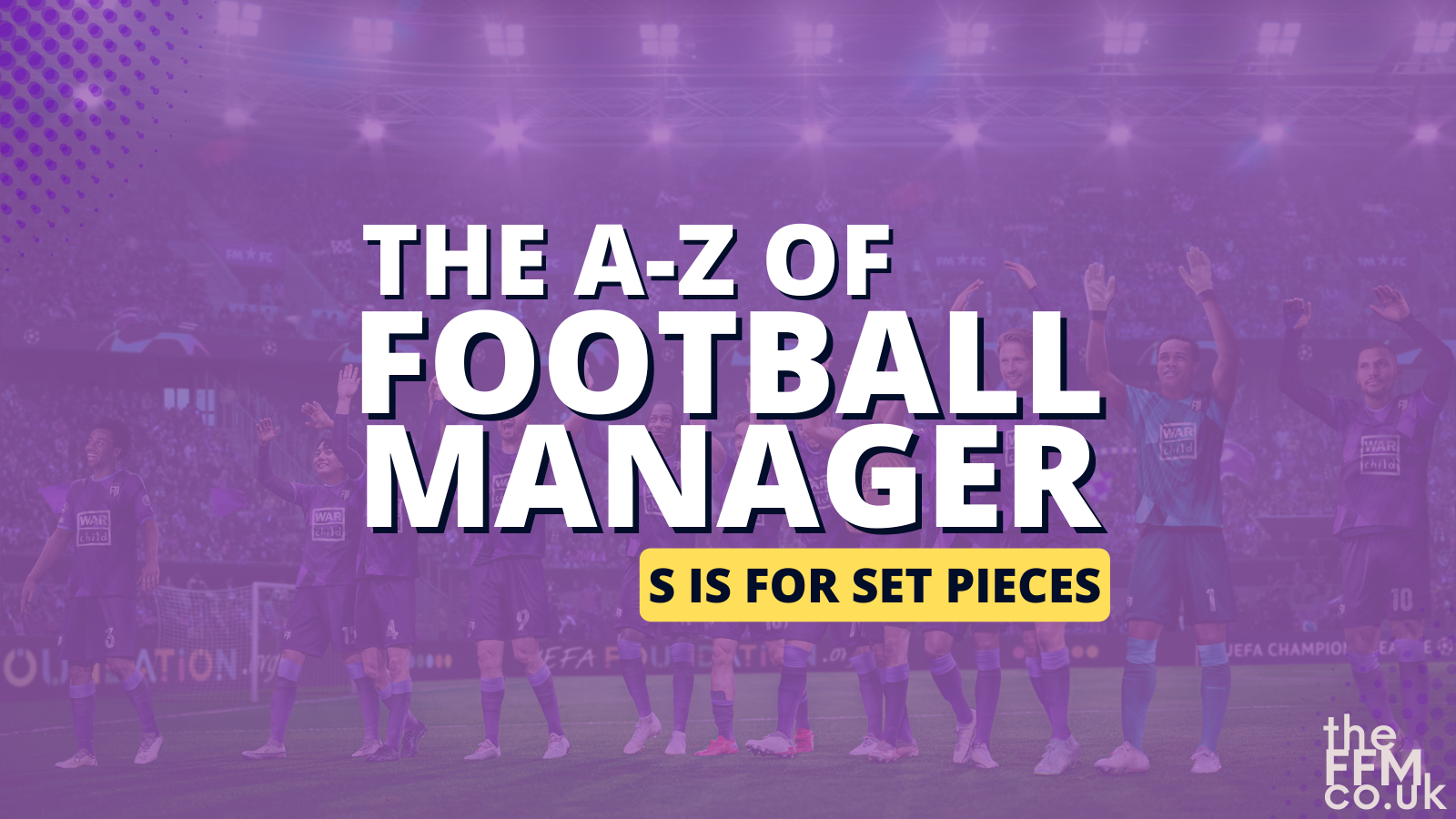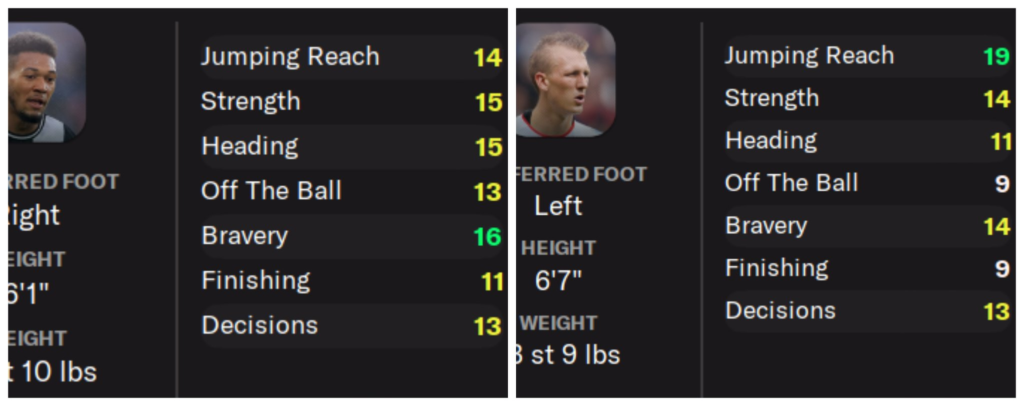
Football Manager A-Z: S for Set Pieces
For previous A-Z entries, please visit: The A-Z of Football Manager.
Today’s guest author is _dscr!
“If God had wanted us to play football in the clouds, he’d have put grass up there.”
Brian Clough
Try telling that to my non-league, six-foot-six, five-passing, head-on-a-stick centre back. That man is good for one thing – 50 CTE-inducing headers a game and I intend to use him as such.
The defending and attacking set pieces are important but often overlooked. In my Millwall save I managed to get both of my centre-backs on double-digit goals. This was vital in dragging an average team up into the playoffs. So, how can this be done?
Firstly, if you want to play your corners short, stop reading now. I hate you and everything you stand for. Go and watch some Pep Guardiola highlights on YouTube or something. If, like a normal person, you want to get the ball in the mixer, I can teach you a few things. There is not one routine that fits all as it is very dependent on what your players have to offer. But these basic rules will be fit for most teams free kicks and corners.
Attacking Set Pieces
Roles
When you pop into the attacking set pieces UI it can seem daunting, but it is simple. Each player fills a role. They can:
- Stay back
- Stay back if needed
- Go forward
- Attack near post
- Attack far post
- Attack ball from edge of area
- Lurk at near post
- Lurk at far post
- Lurk outside the area
- Mark keeper
- Come short

You click a player and then click the role you want them to fill. Some roles allow for multiple players whilst others only allow one. They are self-explanatory, and the game does a good job of letting you know exactly what they will be doing just under the instruction button. You’ll want to be mindful of how many players you send forward. A corner clearance is a key chance for the opposition to start a counter attack.
Attributes
If a player is in the box and expected to challenge for the ball then you’re going to want to check their: Finishing, Heading, Bravery, Decisions, Off the Ball, Jumping Reach and Strength. These players invariably are going to be your tallest, often your CB’s or ST’s, but you shouldn’t make assumptions.
A good case in point would be the difference between Dan Burn and Joelinton at Newcastle. You might assume that Burn, at six-foot-seven, would be the preferred option but let’s look closer. With nineteen jumping reach*, he’s certainly a great target to aim for. However, Joelinton beats or matches him in every single other important attribute and is likely to be a better target for your deliveries.

*There is a common misconception regarding jumping reach. Simply put – a 5’5 player with 15 jumping reach will be able to reach the exact same height as a 6’3 player with 15 jumping reach. The reach includes their height and does not add to it.
Experiment – but don’t mix
Your corners and freekicks can be delivered to the near post, far post, edge of area or 6-yard box. You can also ask your taker to provide mixed deliveries. This last option is almost always a mistake. How are your players supposed to run an effective set piece if no one knows where the hell they are going to kick it? You want to build a routine around one of the options and suitably position your players to take advantage of the perfect delivery.
Train
Old are the tales of traditional managers spending hours on the training pitch on their set pieces. Why should your team be any different? If you want your lads to be effective at set pieces – you’re going to have to dedicate time to train them. You can train in defending corners, attacking corners, defending free kicks, attacking set pieces, and set piece delivery. A mix of each would be ideal, or you could focus on one that you feel your team is particularly weak at.
Defending Set Pieces
Roles
Just like with attacking, there are specific roles your defending players can occupy. They are selected and explained in the same UI as the attacking roles. These are:
- Go back
- Stay forward
- Mark near post
- Mark far post
- Close down corner
- Player mark
- Mark tall player
- Zonally mark near post
- Zonally mark near centre
- Zonally mark centre
- Zonally mark far centre
- Zonally mark far post
- Edge of area
Zonal vs Marking
‘Back in my day you’d pick a man and stick to ‘em’ says my father, without fail, whenever any goal is conceded from a corner. The zonal system has become the whipping boy of every pre-noughties football fan. They are wrong. There isn’t a team in the country that doesn’t adopt some sort of zonal system in their defence. But a pure zonal system would be just as dangerous. A mix is ideal.
In a zonal role, that player will guard a certain area of the box. They won’t move from it and will only attack the ball should it come into that zone. This can be great in making sure that key target delivery points are covered. The issue is that it allows players to get a run on your defenders and extra runners and loose bodies are sometimes left unmarked. In a marking role, that defensive player will stay tight to that player and challenge them. This is good because it makes sure certain players, specifically the more aerially dominating ones, are covered. The issue is that if your defender is beaten then that normally gives the attacker a clear opportunity, especially if the zone they run into is not covered.
The Wall
I affectionately name my own defensive set piece routine as ‘The Wall’. Sadly, these are the things I get excited about in life. It is a closely guarded, decade long system that has been effective across every edition of FM and uses both zonal and man marking. The theory is that the marking players stay tight on the runners to hopefully block their approach. Should they fail, the offensive player then encounters the zonal wall who can deal with the ball. It doesn’t leave much room for a counter, but it’s certainly solid.

I’ll leave you with that. Good luck with your set pieces. Following this advice, hopefully you can squeeze a few more goals in one end and keep a few more out of the other end!